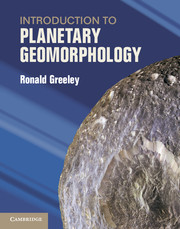Book contents
- Frontmatter
- Contents
- Foreword
- Preface
- Acknowledgments
- Chapter 1 Introduction
- Chapter 2 Planetary geomorphology methods
- Chapter 3 Planetary morphologic processes
- Chapter 4 Earth’s Moon
- Chapter 5 Mercury
- Chapter 6 Venus
- Chapter 7 Mars
- Chapter 8 The Jupiter system
- Chapter 9 The Saturn system
- Chapter 10 The Uranus and Neptune systems
- Chapter 11 Planetary geoscience future
- Appendices
- References
- Further Reading
- Index
Chapter 6 - Venus
Published online by Cambridge University Press: 05 February 2013
- Frontmatter
- Contents
- Foreword
- Preface
- Acknowledgments
- Chapter 1 Introduction
- Chapter 2 Planetary geomorphology methods
- Chapter 3 Planetary morphologic processes
- Chapter 4 Earth’s Moon
- Chapter 5 Mercury
- Chapter 6 Venus
- Chapter 7 Mars
- Chapter 8 The Jupiter system
- Chapter 9 The Saturn system
- Chapter 10 The Uranus and Neptune systems
- Chapter 11 Planetary geoscience future
- Appendices
- References
- Further Reading
- Index
Summary
Introduction
After the Sun and the Moon, Venus is the brightest object in the sky, a consequence of sunlight being reflected from its dense clouds. The planet’s diameter, mass, and gravity are nearly the same as those of Earth (Table 1.1). Along with the presence of an atmosphere, these characteristics led some observers to refer to Venus as Earth’s sister planet. Even as late as the 1960s, some serious researchers thought that the surface of Venus was a wet, tropical environment, possibly teaming with life.
With the dawn of the Space Age, Venus was revealed to be substantially different from Earth. The surface temperature is a hellish 480 °C and exceeds the melting point of lead, while the dense carbon dioxide atmosphere is laced with droplets of sulfuric acid that form dense clouds and exerts a surface pressure of 95 bars, comparable to being underwater on the sea floor of Earth at a depth of 900 m. This leads some wags to refer to Venus as Earth’s evil sister. On the other hand, the geomorphology of Venus displays features indicative of extensive tectonic and volcanic processes (Fig. 6.1), some of which are similar to those on Earth and could be active today, and a surface age of no older than about 750 Ma, much like most of the surface of Earth.
- Type
- Chapter
- Information
- Introduction to Planetary Geomorphology , pp. 106 - 125Publisher: Cambridge University PressPrint publication year: 2013



